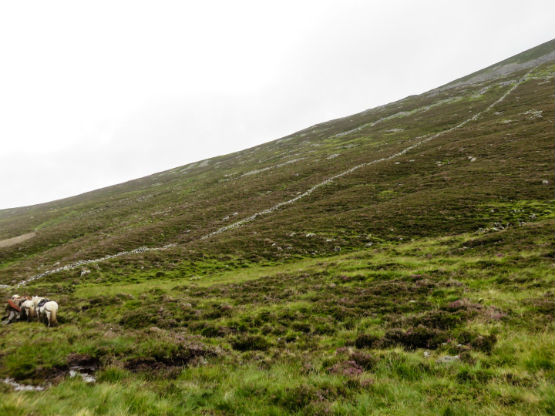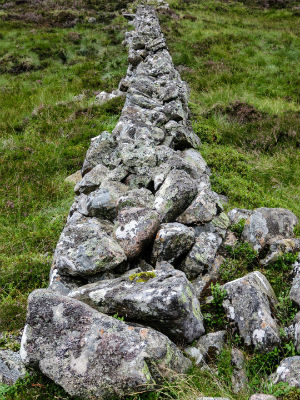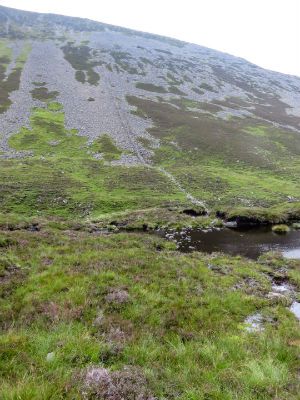Matthew Rogers witnesses an historical, man made phenomenon, the origins of which, may lie in early deer management.

During my recent stalks in the Highlands on the West Hand beat of the Atholl Estate, something caught my eye as being of interest to fellow stalkers. Much of what follows is speculation or hearsay, as readily admitted by Graeme, excellent stalker and 16 year veteran of West Hand on the Atholl Estate. But I don’t think that makes the story any less interesting, for even if you ignore the proposed narrative and consider the photographs alone, it is difficult not to be fascinated by the man made phenomenon that stands some ten miles from the Atholl castle walls.
If you have shot your stag on one side of the beat, you will probably be dragging he beast back to the bottom of the glens and following the burn back to the meeting place with the ponies.
On the journey back, as you pick through the heather and peat alongside the bubbling burn, you will cast your eyes to the hilltops to admire the deer spying you from afar. However, a little over half way through the walk, you look to your right, and your left, and you see a something odd.
 Stretching across the entire glen, from the highest peak to the edge of the burn, is a stone wall. The wall is constructed exclusively by stones found within the vicinity, and clearly by hand with use of heavy tools or cement.
Stretching across the entire glen, from the highest peak to the edge of the burn, is a stone wall. The wall is constructed exclusively by stones found within the vicinity, and clearly by hand with use of heavy tools or cement.
To a certain extent, the experience of finding this wall hits you in waves. Initially, jovial amusement and a sense that “it’s one of those crazy things you see while stalking!” This is replaced by wonderment – how did that wall actually get built? Then reflective pondering – “how would I build that wall?” and “how would I actually like to have to build that wall?!” Finally, you come to the realisation that this must have been back breaking heavy and hard labour for whoever built it. In the faint drizzle and seclusion, you realise that it is a very long way back to town and any accidents would be severe in this harsh and unforgiving landscape. The stalker and ghillie have long since walked on, and for a moment, you and the silent wall are the only two marks of humanity on the landscape. You consider the wall in quiet awe and the wall continues to stand with a timeless grace.
On the last day of the trip, Graeme and I landed ourselves behind a rock near the top of a nearby Monroe to take shelter from the driving rain shower that had just started, and eat lunch. We sat looking out over the magnificent rolling landscape and talked about deer and stalking. The topic of the wall came up. My questions were obvious and unimaginative; I am sure Graeme is asked them by every sportsman that visits his beat, for every one of the sixteen years he has managed it. However he handles my questions with politeness and patience and a frank honesty about what is known.
There is no single conclusive answer to the wall, but research by many and word of mouth has developed a probable theory. It is understood that the wall of most likely constructed by Napoleonic era prisoners of war, shipped to the United Kingdom for supporting the European armies of Napoleon to perform labour too harsh for our own countrymen.
 This sends a shiver down the spine, when, back again in the quiet sanctuary of the valley, the rain and wind gently tugging at your jacket, you consider the hillside pocked with bedraggled soldiers, as prisoners, hauling these heavy stones into place, often at extreme heights and angles on the hillside. How must they have felt, constructing this wall? And to what purpose? Had men died here, constructing this? Was their labour, as possibly lives, worth it?
This sends a shiver down the spine, when, back again in the quiet sanctuary of the valley, the rain and wind gently tugging at your jacket, you consider the hillside pocked with bedraggled soldiers, as prisoners, hauling these heavy stones into place, often at extreme heights and angles on the hillside. How must they have felt, constructing this wall? And to what purpose? Had men died here, constructing this? Was their labour, as possibly lives, worth it?
What cannot be disputed is that the wall runs across many hills and valleys; Graeme off handedly estimates ten further such scenes await those prepared to cross hill after hill. The extent of the wall then becomes immense – and the sensation of wonderment and fear grows further.
So what was it for? Graeme elaborated his thinking on this as the days went past. The general consensus and most likely reason is for the management of deer. While at first one questions what value this would have as a deer fence – after all, it can be easily jumped by even the little Roe, let alone the huge red. However the deer management of two hundred years ago differed significantly from what we do today. The pursuit of deer would be done with larger numbers of people, often driving and herding the deer, and requiring on the beats to be moved to specific choke points to allow for engagement at close range. Firearms were unlikely to be rifled and muskets were the weapon of the sportsman, but many deer still fell to hand held instruments both sharp and blunt; literally everything that could be a weapon would be used. Legend recalls one of the baronial masters of the region dispatching a deer with a single sweeping blow from his sword, slicing the animal in two.
You retreat slowly from the valley, following the ponies, back to the meeting spot; the same meeting spot that was used by villagers of the Atholl to prepare for the drives, hundreds of years before, and admire the same view. The deer wall, then, feels like something of a memorial; as the afternoon sun begins to set and you glance back one last time at it, it feels right to consider it in such a way, given the amount of discomfort, toil, hardship and violence that it endured since inception.
Needless to say the Atholl Estate has moved with the times, and for generations the management of the deer in the landscape has been humane and controlled with an oversight the Victorians would never have believed possible. The deer themselves have also been managed and given a fairer opportunity to make the hills their home, albeit carefully kept in check. Everything about the wall, from its involvement in sport to the construction using penal labour, is out of date, indeed antiquated and uncomfortable. But the wall doesn’t mind, and has gracefully made the transition to being a remote memorial to many different ways of life.
If you have an explanation for 'The Wall' which you would like to share with us, then please email:
Alternatively if you'd like to read more about deer stalking at the Atholl Estate then follow this link: deer-stalking-at-the-atholl-estate



















